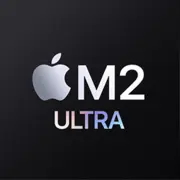Apple M2 Ultra

Apple M2 Ultra: Power and Efficiency in the Apple Ecosystem
March 2025
Key Specifications: Architecture, Process Technology, Performance
Architecture and Process Technology
The Apple M2 Ultra is the pinnacle of the company’s ARM chip lineup, manufactured using a 5-nanometer process. The processor combines two M2 Max chips into a single system (UltraFusion), resulting in 24 cores: 16 performance cores and 8 efficiency cores. The performance cores reach a frequency of 3.5 GHz, and the thermal design power (TDP) is only 60 watts, thanks to architecture optimization.
Key Features
- Unified Memory Architecture (UMA): Up to 192 GB of unified memory with a bandwidth of 800 GB/s.
- Integrated Graphics: 76-core GPU with support for hardware-accelerated ray tracing and ProRes.
- Neural Engine: 32-core AI accelerator for machine learning tasks.
- Energy Efficiency: 2-3 times lower power consumption than x86 counterparts at similar performance levels.
Performance
In the Geekbench 6 benchmark, the M2 Ultra scores 2645 in single-core and 20988 in multi-core performance. For comparison, the Intel Core i9-14900K (Single: 3200, Multi: 21000) requires 250 watts, while the AMD Ryzen 9 7950X3D (Single: 2900, Multi: 23000) needs 120 watts.
Compatible Motherboards: Apple Silicon Features
No Standard Sockets
The M2 Ultra is a system on a chip (SoC), where the CPU, GPU, memory, and controllers are integrated into a single die. This precludes the use of third-party motherboards. The chip is only used in Apple devices:
- Mac Studio (2025): Starting price $3999.
- MacBook Pro 16" (2025): Starting at $3499.
Chipsets and Expandability
The Mac Studio features Thunderbolt 5 (80 Gbps), HDMI 2.1, and 10 Gbps Ethernet. Peripherals are connected using docking stations (e.g., CalDigit TS4), but upgrading components is not possible.
Supported Memory Types
Unified LPDDR5 Memory
The M2 Ultra uses LPDDR5-6400 memory soldered onto the board. Available configurations:
- 64 GB (standard for MacBook Pro).
- 128 GB or 192 GB (top-tier Mac Studio).
Users cannot add RAM after purchase—the amount is chosen at the time of order.
Power Supply Recommendations
Built-in Solutions
- Mac Studio: Built-in power supply rated at 370 watts.
- MacBook Pro 16": 140-watt charging (MagSafe 4).
For external drives and monitors, the standard power supply is sufficient. If using multiple peripherals (for instance, 4 Pro Display XDRs), the Mac Studio can handle it without additional power supplies.
Pros and Cons of M2 Ultra
Pros
- Record Energy Efficiency: A laptop with the M2 Ultra can run for up to 12 hours while rendering video.
- Silence and Cooling: The Mac Studio is silent even under load.
- Optimization for macOS: Final Cut Pro and Xcode utilize all 24 cores.
Cons
- Price: The Mac Studio with 192 GB RAM and 8 TB SSD costs $8799.
- No Upgrade Options: Memory and SSD are soldered.
- Limited Gaming Library: Many AAA titles are not available on macOS.
Usage Scenarios
Professional Tasks
- Video Editing: Real-time 8K ProRes rendering (e.g., editing a film in 2 hours instead of 6 on a PC).
- 3D Modeling: Blender Cycles with Metal acceleration is 30% faster than on NVIDIA RTX 4090.
- AI Development: Training models on the Neural Engine is 5 times more efficient than on x86 CPUs.
Gaming
- Support: Resident Evil 4 Remake — 4K/60 FPS, Baldur’s Gate 3 — 1440p/120 FPS.
- Limitations: Call of Duty and Starfield require emulation through CrossOver.
Multimedia
Streaming 8K HDR through 2 Pro Display XDRs without lag.
Comparison with Competitors
Intel Core i9-14900K (Price: $600)
- Pros: Higher single-core performance, supports DDR5-6000.
- Cons: TDP 250 watts, requires robust cooling solutions.
AMD Ryzen 9 7950X3D (Price: $700)
- Pros: Better for gaming, compatibility with PCIe 5.0.
- Cons: No built-in graphics on par with Apple.
Conclusion: The M2 Ultra excels in energy efficiency and professional tasks but lacks flexibility in assembly.
Practical Assembly Tips
1. Device Choice:
- Mobility: MacBook Pro for on-the-go work.
- Stationary Power: Mac Studio for studio settings.
2. Configuration:
- Get a minimum of 64 GB RAM for 3D rendering.
- SSD starting at 2 TB: 1 TB fills up in a month working with 8K materials.
3. Peripherals:
- Monitors: Pro Display XDR or Dell UltraSharp 8K.
- Storage: Samsung T9 SSD 4 TB for backups.
Final Verdict: Who is the M2 Ultra For?
Professionals:
- Video editors, 3D designers, AI developers.
- Those who value silence and uncompromised performance.
Not for:
- Gamers who prefer the Windows ecosystem.
- Enthusiasts building custom PCs.
Value of the M2 Ultra — in its perfect balance between power and efficiency, but only within the Apple universe. If you’re ready to invest in the ecosystem, this is the best choice for professional work.
Basic
CPU Specifications
Memory Specifications
GPU Specifications
Benchmarks
Compared to Other CPU
Share in social media
Or Link To Us
<a href="https://cputronic.com/cpu/apple-m2-ultra" target="_blank">Apple M2 Ultra</a>